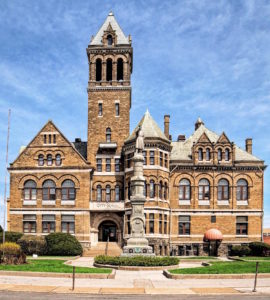Chamber History
On Tuesday, December 15, 1885 a group of Williamsport businessmen met in the “Common Council Chambers” to elect the first officers of the Board of Trade; thus starting an organization that has continued on to this day and is now known as the Williamsport/Lycoming Chamber of Commerce.
On that first night, Emanuel Andrews Esq. was selected as Chairman and L.M. Otto Esq. was selected to serve as Secretary. Other business conducted that evening was the election of a full Board of Directors and the adoption of the organization’s bylaws.

When the Board of Trade convened and elected its first Board of Directors, it was, in large part, a response to the decline of the lumbering industry and the need to rebuild Williamsport’s economy by building a diverse manufacturing base. Over the course of its formative years, the Board of Trade had considerable success in bringing in new manufacturers to hire the residents of Williamsport and its surrounding communities. Interestingly, the Board of Trade took extraordinary steps to not only lure companies here, but to ensure their success. After several meetings of different manufacturing sections of the local economy, the Executive Committee of the Board of Trade hired Mr. Chas C. Krouse to represent the manufacturers of Williamsport in Washington, D.C. to secure as much war-related business as possible for Williamsport manufacturers.
On August 21, 1901 the current 25 members of the Board of Trade met to propose a restructuring of their organization to attract more industries to Williamsport. By 1903 seven firms, employing 500 men, settled into the city. The Board of Trade was able to measure their success by the economic prosperity of the city. In 1904 Manager Laird’s annual address cited Williamsport as “The Ideal City for Home or Business”. The print material promoting the prosperity of Williamsport’s manufacturing was distributed by the thousands. The number of established firms in Williamsport grew from 115 in 1904 to 154 in 1909. An article by the New Jersey Commerce and Finance magazine said, “Their growth isn’t spasmodic, but it’s every week and every year that something is being done to better the community. There is something wonderfully inspiring about a city that can do things.”
In April of 1914, the Board of Trade reorganized again, this time with a purpose going beyond attracting new business to the area. The Board’s ability to turn ideas for industrial improvements into executed plans of action made them stand out from other business associations. By the spring of 1915, an industrial training program in the form of continued education was created and became known as the Shopschool. It offered men in their teens and twenties a place to attend classes on wood working and metal working. Revenues for the school came from work orders placed by manufacturers and completed by the students. The school was able to pay 43 percent of their costs while the state paid the remaining 57 percent.
The Board was able to influence not only business development but community development as well. The industrial development of local manufacturing facilities forged a demand for conveniently located, affordable housing of the workmen. Reasonably priced, modern homes were provided to the working class.
Williamsport quickly established itself as an up-and-coming city to live, work and shop. June, 1914 through November, 1915 was a progressive time in Williamsport’s history due to the efforts of the reorganized Board of Trade. Over the years that followed, the Board of Trade continued to grow and prosper. Known today as the Williamsport/Lycoming Chamber of Commerce, much has changed since the early 1900s, but much has remained the same. While issues and people came and went, the basic purpose of the organization has never truly changed; An organization made up of business professionals dedicated to maintaining a strong business climate and local economy that helps to provide jobs for the local community.